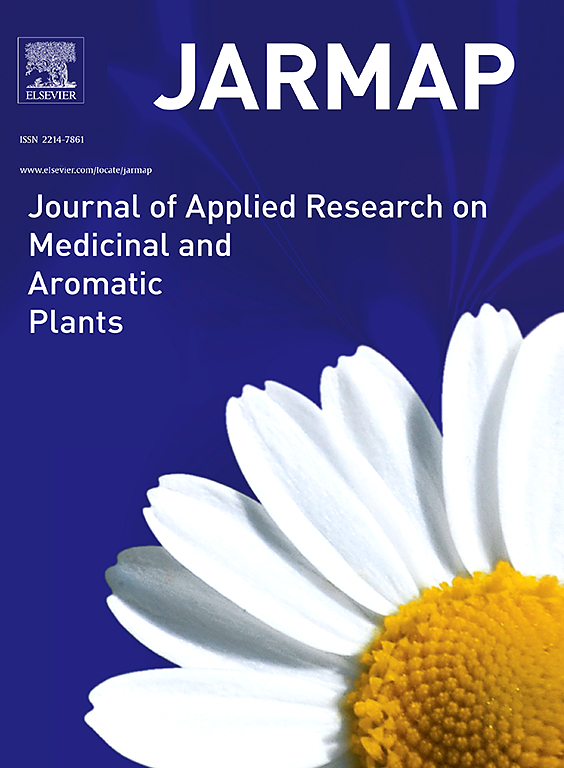解决药用植物分类的复杂性:基因组尺度的系统发育和超条形码促进物种鉴定和保护
IF 3.6
2区 农林科学
Q1 PLANT SCIENCES
Journal of Applied Research on Medicinal and Aromatic Plants
Pub Date : 2025-05-01
DOI:10.1016/j.jarmap.2025.100643
引用次数: 0
摘要
双菊属植物是五加科植物中最大的一种,在东亚的传统医学中已经使用了几个世纪。然而,由于其形态的复杂性和杂交/渗入现象的普遍存在,给准确的物种鉴定带来了很大的挑战,从而阻碍了这些药用植物的开发、保护和应用。本研究利用数百个核位点的序列和完整的质粒进行了系统发育关系的重建,并对12种不同的条形码系统进行了鉴定。研究发现,这些物种的质体体长度、基因含量和序列高度保守,而倒置重复区在温带和热带/亚热带谱系之间表现出差异,为地理溯源提供了新的标记。基于基因组尺度数据构建的系统发育关系证实,中国异花楤木组为单系系,由3个支持良好的谱系组成。谱系分选不全和杂交不全是造成树间系统发育冲突的主要因素。物种鉴别分析表明,采用整合全质体和nrDNA序列的超条形码策略,对菊苣属(Aralia sect. Dimorphanthus) 14种植物的物种鉴定准确率达到92 %,优于标准条形码。虽然该系统解决了大多数分类上的歧义,但通用核标记的包含对于解决像elata这样高度可变的分类群的歧义至关重要。这些进步直接支持工业对可靠的物种认证和生物多样性保护的需求。本文章由计算机程序翻译,如有差异,请以英文原文为准。
Resolving taxonomic complexities in medicinal Aralia: Genome-scale phylogeny and super-barcoding advance species identification and conservation
Aralia section Dimorphanthus represents the largest section in Araliaceae and has been employed in East Asian traditional medicine for centuries. However, the morphological complexity and the prevalence of hybridization/introgression posed a great challenge for accurate species identification, thereby hindering the development, conservation and application of these medicinal plants. In this study, we employed sequences of hundreds of nuclear loci and the complete plastomes to reconstruct the phylogenetic relationships, and evaluated the effectiveness of 12 distinct barcode systems for distinguishing Chinese species of Aralia sect. Dimorphanthus. We found that plastome length, gene content, and order of these species were highly conserved, while the inverted repeat regions showed variability between temperate and tropical/subtropical lineages, providing novel markers for geographical traceability. Phylogenetic relationships constructed based on the genome-scale data confirmed that Chinese Aralia sect. Dimorphanthus was monophyletic and comprised three well-supported lineages. Incomplete lineage sorting and hybridization were identified as the main factors contributing to the phylogenetic conflicts among trees. Species discrimination analysis revealed that super-barcoding strategies integrating complete plastomes and nrDNA sequences, achieved a 92 % species identification accuracy among the 14 studied species of Aralia sect. Dimorphanthus, outperforming standard barcodes. While this system resolved most taxonomic ambiguities, the inclusion of universal nuclear markers is crucial to resolve ambiguities in highly variable taxa like A. elata. These advancements directly support industrial needs for reliable species authentication and biodiversity conservation in pharmacologically important species.
求助全文
通过发布文献求助,成功后即可免费获取论文全文。
去求助
来源期刊

Journal of Applied Research on Medicinal and Aromatic Plants
Pharmacology, Toxicology and Pharmaceutics-Drug Discovery
CiteScore
6.40
自引率
7.70%
发文量
80
审稿时长
41 days
期刊介绍:
JARMAP is a peer reviewed and multidisciplinary communication platform, covering all aspects of the raw material supply chain of medicinal and aromatic plants. JARMAP aims to improve production of tailor made commodities by addressing the various requirements of manufacturers of herbal medicines, herbal teas, seasoning herbs, food and feed supplements and cosmetics. JARMAP covers research on genetic resources, breeding, wild-collection, domestication, propagation, cultivation, phytopathology and plant protection, mechanization, conservation, processing, quality assurance, analytics and economics. JARMAP publishes reviews, original research articles and short communications related to research.
 求助内容:
求助内容: 应助结果提醒方式:
应助结果提醒方式:


